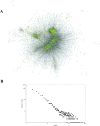A census of P. longum's phytochemicals and their network pharmacological evaluation for identifying novel drug-like molecules against various diseases, with a special focus on neurological disorders
- PMID: 29320554
- PMCID: PMC5761900
- DOI: 10.1371/journal.pone.0191006
A census of P. longum's phytochemicals and their network pharmacological evaluation for identifying novel drug-like molecules against various diseases, with a special focus on neurological disorders
Abstract
Piper longum (P. longum, also called as long pepper) is one of the common culinary herbs that has been extensively used as a crucial constituent in various indigenous medicines, specifically in traditional Indian medicinal system known as Ayurveda. For exploring the comprehensive effect of its constituents in humans at proteomic and metabolic levels, we have reviewed all of its known phytochemicals and enquired about their regulatory potential against various protein targets by developing high-confidence tripartite networks consisting of phytochemical-protein target-disease association. We have also (i) studied immunomodulatory potency of this herb; (ii) developed subnetwork of human PPI regulated by its phytochemicals and could successfully associate its specific modules playing important role in diseases, and (iii) reported several novel drug targets. P10636 (microtubule-associated protein tau, that is involved in diseases like dementia etc.) was found to be the commonly screened target by about seventy percent of these phytochemicals. We report 20 drug-like phytochemicals in this herb, out of which 7 are found to be the potential regulators of 5 FDA approved drug targets. Multi-targeting capacity of 3 phytochemicals involved in neuroactive ligand receptor interaction pathway was further explored via molecular docking experiments. To investigate the molecular mechanism of P. longum's action against neurological disorders, we have developed a computational framework that can be easily extended to explore its healing potential against other diseases and can also be applied to scrutinize other indigenous herbs for drug-design studies.
Conflict of interest statement
Figures










Similar articles
-
Deciphering the multi-scale mechanisms of Tephrosia purpurea against polycystic ovarian syndrome (PCOS) and its major psychiatric comorbidities: Studies from network pharmacological perspective.Gene. 2021 Mar 20;773:145385. doi: 10.1016/j.gene.2020.145385. Epub 2020 Dec 29. Gene. 2021. PMID: 33383117
-
Deciphering the Anticancer Arsenal of Piper longum: Network Pharmacology and Molecular Docking Unveil Phytochemical Targets Against Lung Cancer.Int J Med Sci. 2024 Jul 22;21(10):1915-1928. doi: 10.7150/ijms.98393. eCollection 2024. Int J Med Sci. 2024. PMID: 39113883 Free PMC article.
-
Molecular modelling, docking and network analysis of phytochemicals from Haritaki churna: role of protein cross-talks for their action.J Biomol Struct Dyn. 2024 May;42(8):4297-4312. doi: 10.1080/07391102.2023.2220036. Epub 2023 Jun 8. J Biomol Struct Dyn. 2024. PMID: 37288779
-
Traditional Chinese medicine formulas for the treatment of osteoporosis: Implication for antiosteoporotic drug discovery.J Ethnopharmacol. 2016 Aug 2;189:61-80. doi: 10.1016/j.jep.2016.05.025. Epub 2016 May 11. J Ethnopharmacol. 2016. PMID: 27180315 Review.
-
Traditional uses, phytochemistry and pharmacological properties of Neolamarckia cadamba: A review.J Ethnopharmacol. 2016 Apr 2;181:118-35. doi: 10.1016/j.jep.2016.01.036. Epub 2016 Jan 25. J Ethnopharmacol. 2016. PMID: 26821190 Review.
Cited by
-
Water Extract of Piper longum Linn Ameliorates Ovariectomy-Induced Bone Loss by Inhibiting Osteoclast Differentiation.Nutrients. 2022 Sep 5;14(17):3667. doi: 10.3390/nu14173667. Nutrients. 2022. PMID: 36079923 Free PMC article.
-
Identifying the Compounds of the Metabolic Elicitors of Pseudomonas fluorescens N 21.4 Responsible for Their Ability to Induce Plant Resistance.Plants (Basel). 2020 Aug 12;9(8):1020. doi: 10.3390/plants9081020. Plants (Basel). 2020. PMID: 32806693 Free PMC article.
-
Efficacy and Mechanism of Core Traditional Chinese Medicines for Treating Malignant Lymphoma based on Efficacy Studies: A Study Supported by Network Pharmacology and Molecular Docking.Curr Pharm Des. 2024;30(33):2652-2666. doi: 10.2174/0113816128308565240710114350. Curr Pharm Des. 2024. PMID: 39082169
-
Molecular docking analysis of COX-2 with compounds from Piper longum.Bioinformation. 2021 Jun 30;17(6):623-627. doi: 10.6026/97320630017623. eCollection 2021. Bioinformation. 2021. PMID: 35173384 Free PMC article.
-
Insights about multi-targeting and synergistic neuromodulators in Ayurvedic herbs against epilepsy: integrated computational studies on drug-target and protein-protein interaction networks.Sci Rep. 2019 Jul 22;9(1):10565. doi: 10.1038/s41598-019-46715-6. Sci Rep. 2019. PMID: 31332210 Free PMC article.
References
-
- Johri RK and Zutshi U (1992). An Ayurvedic formulation ‘Trikatu’ and its constituents. Journal of Ethnopharmacology 37: 85–91. - PubMed
-
- Das and Sharma (2002). Caraka Samhita. Chowkhamba Sanskrit Series, Varanasi.
-
- Srikantha Murthy KR (2012). Susruta Samhita. Chaukhamba Orientalia, Varanasi.
-
- Srikantha Murthy KR (2000). Vagbhata’s Astanga Hrdayam. Chaukhamba Orientalia, Varanasi.
-
- Tripathi DM, Gupta N, Lakshmi V, Saxena KC and Agrawal AK (1999). Antigiardial and immunostimulatory effect of Piper longum on giardiasis due to Giardia lamblia. Phytotherapy Research 13: 561–565. - PubMed
Publication types
MeSH terms
Substances
LinkOut - more resources
Full Text Sources
Other Literature Sources
Medical

